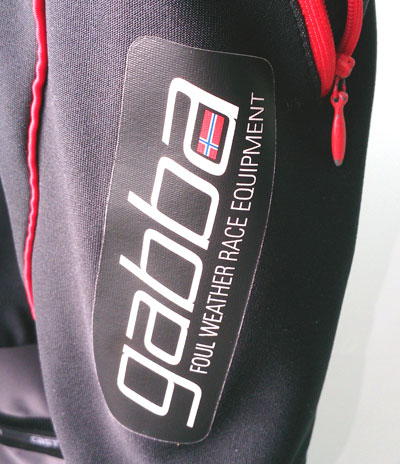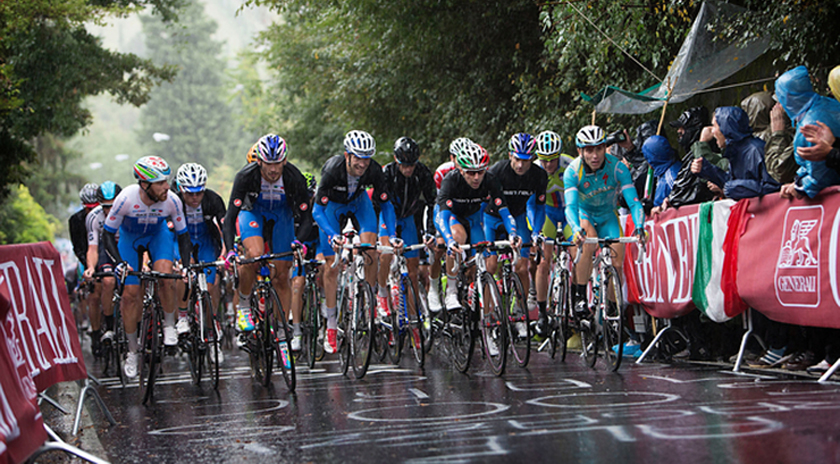Rain. You might have to race in it and certainly will have to train in it. It might just be a quick shower followed by glorious sun or could be dark and almost snowing. It'll wear out your equipment and if get cold you will easily get sick.
What is the best way to ride safely warmly in the rain?
What is the best way to ride safely warmly in the rain?
While some people may love riding in freezing rain, most despise it. Riding in the rain doesn't make you a tough guy, it just makes you fed up of cycling!
Check the weather forecast. If it is likely to be raining in the afternoon then ride in the morning. Get the riding done then sit back and watch it pouring down outside when you're all wrapped up warm.
Consider not starting a race or event unless it is an important one. Circuit races - criteriums - are especially dangerous due to the high speeds, many corners and town center road markings and metal drain covers. The first and last laps of such a race are the most dangerous. It isn't a bad idea to pull out if it rains. This isn't giving up, but a decision to 'race for tomorrow'. I have seen plenty of top riders pull out when it starts raining.
Cut your ride shorter. If you were planning a 7 hour epic then do it another day or make it 4 hours.
The turbo is another option. If you were planning some intervals then the turbo will be an excellent substitute. Some people can do 5 hour endurance rides on the turbo, but I find it too mentally tough.
If you do need to ride in the rain, then you need to dress appropriately. Riding for 2 -3 hours in the rain wearing just shorts, vest and short sleeve jersey is a good way to get frozen and sick. You might feel that you would never be that stupid, but it is easy to misjudge the temperature, or conditions may change. You may stay warm in the first hour by riding fast, but as you tire you will get colder.
Expect to get wet, but the important point is to stay warm by avoiding wind chill.
Shoe covers
There are some very good light waterproof covers, e.g. Castelli Nano Shoecover
A lot of riders also use Castelli Toe Thingy
Bare legs
I have not seen any totally waterproof leggings. Normal Lycra will soak up water and make your legs even colder as it evaporates. Consider going bare legged as the water will just run off your legs. If you do go bare legged, be sure to wrap your top half well.
Body
The best garment I have ever used for wet or cold cycling is the Castelli Gabba jersey $190

The Gabba jacket is actually as good as they say it is. Most importantly it keeps the wind off you when soaking wet, but doesn't absorb too much water.
Other manufacturers are copying the idea:
- Craft 2014 Men's Elite Weather Jersey $150
- Capo Lombardia Jersey $160. Has a fleece lining.
- Santini H20 Jersey, $160 A bit flimsier than the other jerseys. Not windproof, so inferior to the Gabba.
- Vermarc Aqua Zero Jersey EURO 100. A bit clumsier than the Gabba, in that the fit is looser and there's a flappy fanny flap at the back. But designed and used in Belgium, it does the trick.
You don't need many layers with the Gabba long sleeve.
46F-60F (8-15C) and rain - base layer + Gabba
32F-46F (0-8C) and rain - Long sleeved base + long sleeved jersey + Gabba
Below 32F - stay inside
Pair the short sleeved version with Castelli Nano Flex Arm Warmers $50
Typical thermal jackets such as the Assos Airblock are no good in prolonged heavy rain. They absorb water and become cold and heavy.
Gloves
Neoprene gloves $45
Waterproof jackets
The majority of cheap waterproof jackets are not waterproof and do little to help keep you warm. They only act as a parachute.
I see a lot of beginners riding around with a fold up waterproof jacket in their back pocket. I find that it is rarely needed. If there is a light shower, then there's no point putting on the jacket. If it is torrential then the jacket won't help.
If you have a Castelli Gabba
However if you must buy a rain jacket, then by quality, such as a Gore-Tex Fusion 2.0 $283 or eVent Castelli Muur $283 jacket. I own a few but have rarely used them.
Sunglasses/ glasses
Clear cycling glasses are essential as grit thrown up from riders in front will soon cause discomfort when it goes in your eyes. Unfortunately the glasses also tend to steam up or become hard to see through. You will be then tempted to take them off, which will be great for about 5 minutes until your eyes fill with grit.
Hats
The most important aspect of wearing a hat in wet weather is the peak. This will prevent road spray from going straight into your eyes. If you have taken your sunglasses off, then the peak may save you from the worst of the spray.
There are some waterproof hats which are useful to wear in downpours. Most are made of wool or cotton, become waterlogged and heavy and of course cold.
The wet weather bike
If you live in a wet area such as the North West Coast, it is a good idea to have a winter bike/ wet weather bike. Bearings, chains, cables, rims, brake blocks all get worn quickly in wet conditions. When you get on your summer bike it will feel blissful.
Tires
When it rains you are more likely to puncture as gravel is washed into the road and flints are realigned with sharp edge upwards.
Unless you have a support car and money to burn, don't use your tubular tires and carbon rims in the rain. I have seen lots of people turning up for a group ride with their Zipp 404 tubular wheels
Robust winter tires with a Kevlar strip work best. E.g. Continental GatorSkin
If racing in the wet, you will have to use your light tires and hope for the best. It is accepted wisdom to reduce tire pressure by 10PSI when riding in the wet. I do this as it makes me feel more confident when cornering.
However, cornering grip is basically independent of tire pressure and thus contact patch area. The most important factor is the coefficient of friction between the road and rubber, i.e. the rubber compound. The friction equation tells us that with a given coefficient of friction, the maximum lateral force the tire will withstand before it loses grip is proportional to the force pressing the tire to the ground. The patch area or shape is irrelevant, so you may as well pump your tires as hard in the wet as you do in the dry.
Fenders/ mudguards
Fenders will keep the worst of the grit off your bike and will keep most of the water off your backside. It is courteous to use fenders when riding with a group. It isn't pleasant to be hosed with road water for 4 hours, although quite a lot of that water does come from your own front wheel.
The clip on SKS raceblades $54
Lights
If the light is poor due to misty, rainy weather, then it is a good idea to put your lights on. Best to be visible. Do remember to angle the front lights down - there's no point blinding everyone with your megawatt lighthouse system.
Cleaning your bike
Always give your bike a hose down after riding in the wet. This removes dung, mud, grit and salt.
After every wet ride you should use the chain cleaner to get rid of the grit on your chain, and re-lube it. The lube will have been washed off in the rain. It is a pain to do this every time, but it will greatly prolong the life of your chain and sprockets.
Finally if you can make the time, use soapy water to clean the black road residue off your rims. Remove the wheels and pick out any grit in your brake blocks. Obviously grit on aluminium or carbon rims will wear them out.
Bottles
If you live in an area with a lot of mud and dung on the roads, it is a good idea to buy some bottles with a cover over the mouthpiece. I have seen many people get sick after drinking from a bottle that has had dung sprayed on it.
Racing in the wet
As stated above, you need to stay as warm as you can without carrying too much weight. The Castelli Gabba
Before the end of the race, before the sprints start, it is a good idea to warm yourself up. You might have been chugging along in the pack or in a break, and a sudden increase in pace will leave you standing. Get to the front of the group and do some fairly hard turns. Obviously you don't want to exhaust yourself, but you need to get warm so you will be ready to attack.
Conclusion
Some people relish riding in the rain. They say 'toughen up!' But for the majority, riding in the rain can be a miserable experience that wears out your bike in double quick time.
If you dress appropriately and use a spare bike with fenders and sturdier tires, your hours in the wet need not be so demanding.
Embrace the weather, as it is part of the joy of the open road.
Links
Castelli Gabba WS Rain Short Sleeve Jersey - Men's
Castelli Gabba Jersey from Wiggle
Craft 2014 Men's Elite Weather Jersey $150
Capo Lombardia Jersey $160. Has a fleece lining.
Santini H20 Jersey, $160 A bit flimsier than the other jerseys. Not windproof, so inferior to the Gabba.
Vermarc Aqua Zero Jersey EURO 100. A bit clumsier than the Gabba, in that the fit is looser and there's a flappy fanny flap at the back. But designed and used in Belgium, it does the trick.
